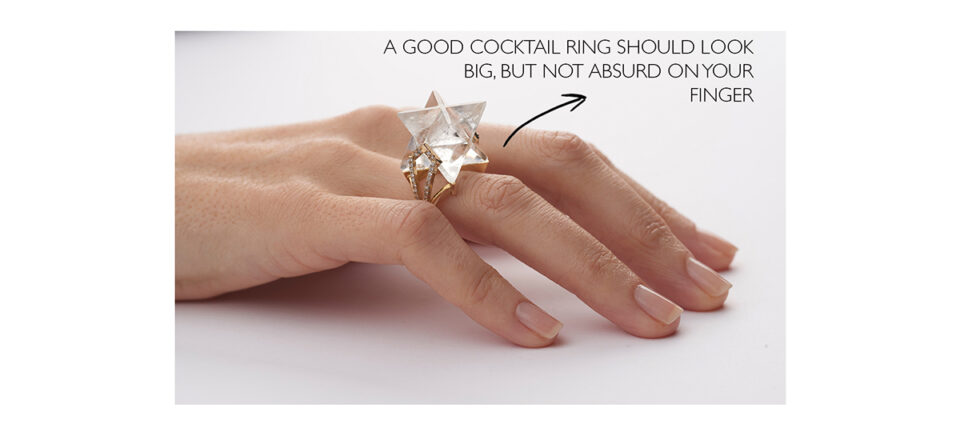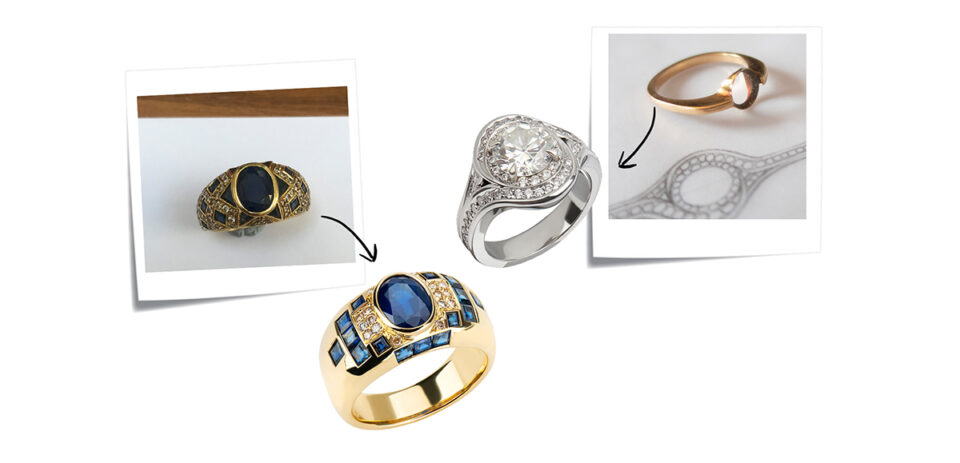
October 2019
OUR COMPLETE GUIDE TO CHOOSING A COCKTAIL RING
CONTENTS
♦ What is a cocktail ring
♦What is the origin of a cocktail ring?
♦ How do I wear a cocktail ring? What are the rules?
♦ What metal is right for a cocktail ring?
♦ Are there any other metals or finishes I should be aware of?
♦ What should I consider when buying a cocktail ring?
♦ Going vintage
♦ Can I update my old cocktail ring?
♦ Caring for a cocktail ring

WHAT IS A COCKTAIL RING?
The cocktail ring is a typically large, flamboyant and pronounced piece of jewellery worn on the middle finger or fourth finger of the right hand. Also known as a ‘cluster ring’ or ‘dinner ring’, it normally sits proud and raised off the finger unlike the traditional wedding band or eternity ring, which is lower in profile and flush to the skin.
Bold, audacious and statement in design, these rings are generally worn from ‘cocktail hour’ onwards as their colour, size and shape does not always deem them practical for all-day, every-day wear.
Historically, cocktail rings were comprised of a prominent, central stone surrounded by a coronet of smaller stones. Modern-day designs do not adhere to this rhetoric – when it comes to cocktail rings anything vivacious and vibrant goes!
Examples of Tessa Packard London cocktail rings include the Whoops-a-Daisy Ring, the Shanghai Fire Ring and the Cocktail Hour Ring.
WHAT IS THE ORIGIN OF THE COCKTAIL RING?
Cocktail rings first emerged in the jazz-age of the 1920s as a symbol of opposition to Prohibition. During that time, an alcoholic cocktail was about as rebellious a status symbol as you could get. Making sure that everyone noticed your illicit drink was equally important – particularly for women – who were beginning to challenge their proscribed role in the home and society. The cocktail ring – in all its colourful, blinging glory – was thus invented as an emblem of female independence and became the perfect accessory at secret parties in towns and cities across America.
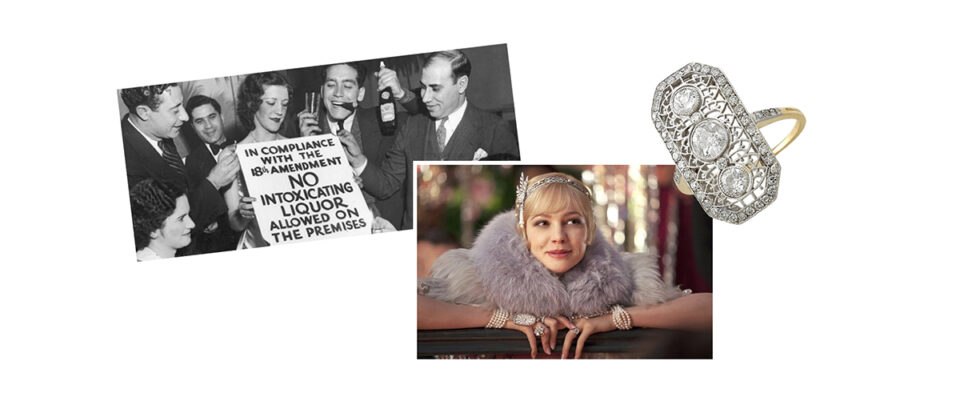
The popularity of the cocktail ring continued to thrive amongst the wealthy and elite throughout the 1930s, 1940s and 1950s. Whilst the 1960s saw a decline in status of this accessory due to changing styles, the cocktail ring came back into fashion in the 1980s, and has endured ever since as a popular evening accoutrement for men and women alike.
HOW DO I WEAR A COCKTAIL RING? WHAT ARE THE RULES?
In general, there are no hard and fast rules! However, many still to choose to wear a cocktail ring on their right hand to avoid a clash (or confusion) between it and their engagement ring. If your engagement ring is particularly statement or colourful it is probably best to observe this tradition.
Statement jewellery needs room to breathe when worn and putting two pieces of bold design in close proximity to one another – especially on the same hand – can lead to a hot mess. If in doubt, keep statement rings apart.
Another aspect we are often asked about at Tessa Packard London is colour: should your jewellery match your outfit? Again, there are no strict rules about how you should co-ordinate your clothes with your rings. Some people feel more comfortable keeping both in the same colour family, for example wearing a blue-stoned cocktail ring (like our Manhattan Ring) with a green, blue or turquoise dress. Others love to clash colours, pairing purple hued cocktail jewellery with an orange ensemble. Ultimately, the cocktail ring is all about making a statement, so as long as it is bold and statement in design, how you accessorise it is up you.
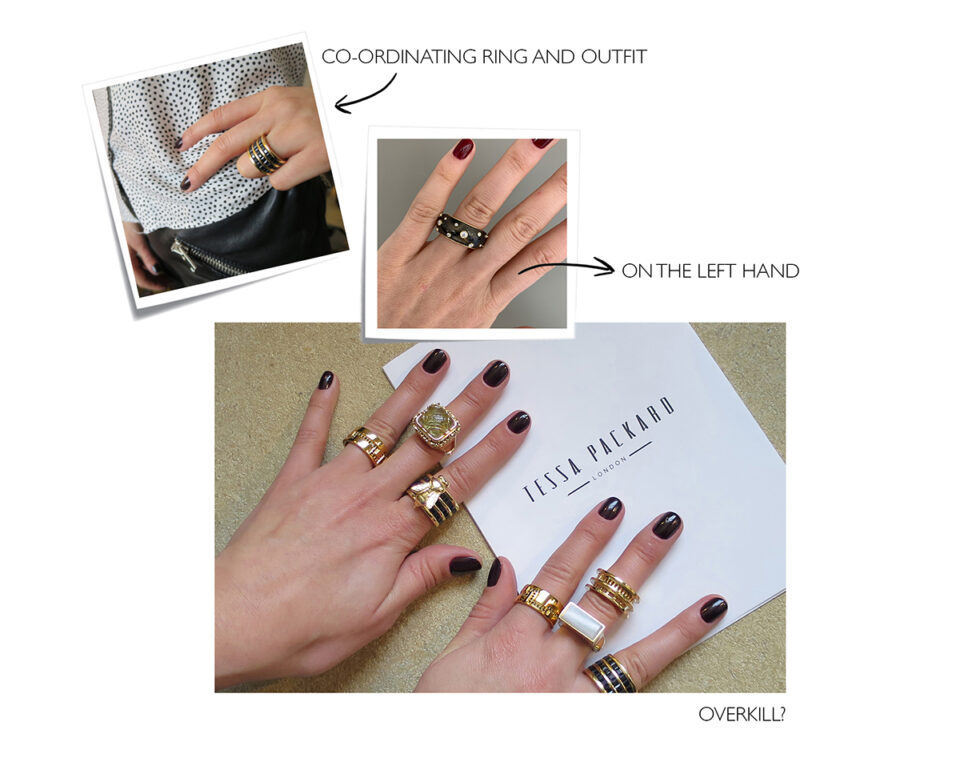
The final question is when to wear a cocktail ring? Historically, these accessories were firmly reserved for the evenings – cocktail parties, dinner parties and black-tie events. Nowadays, this tradition has thankfully changed and many people are enjoying the benefits of a day-time cocktail ring. Nothing makes a denim-white-shirt outfit sing like a good bit of rock on the finger.
In our opinion, a great day-time cocktail ring should be statement but not garish or overly bling. It should rely more on design than carat weight to impress. Something very diamond-heavy or gaudy is inappropriate, whereas a ring made of neutral-toned stones (such as white agate, black onyx, jade, rock crystal, blue sapphire or pearl) will be much more palatable to the eye and easier to wear on a regular basis. It will also co-ordinate beautifully with a multitude of outfits, making it multifunctional and extremely good value for money.
Good examples of day-time cocktail rings from our collections include the Antarctica Ring, the Cocktail Sting Ring, the Longitude Ring and the Pharaoh Ring. Each of these rings are subtle yet statement at the same time.
WHAT METAL IS RIGHT FOR A COCKTAIL RING?
Cocktail rings can come in a wide variety of metals, from silver to platinum, 9ct rose gold to 18ct yellow gold vermeil and gold-plated cocktail rings. Because there is so much choice, it’s important to consider the pros and cons of each when buying a cocktail ring.
The first aspect to consider is metal colour, as this will often narrow the wearer’s options down by half. By putting a silver ring, rose gold ring and yellow gold ring on your finger in turn, you will be able to see which metal tone (rose, yellow or silver) works best with your skin colour. For some, it is easily evident what doesn’t work.
For example, hands with natural reddish or pink hue should stay away from rose-gold rings (as the rose colour in the metal only emphasises the red tones of the skin); those who are very pale should look to wear warm, gold-toned jewellery on their hands instead of colder silver-toned jewellery to reduce any skin whiteness. However, there are some lucky people who can wear all three metal types, and for them, metal choice can be based on durability and aesthetics solely.
With regards to durability, some metals are definitely more long-lasting than others. With gold, it is important to avoid 24ct gold as this pure metal alloy is too soft for jewellery. One whack of the hand and any cocktail ring would be bent out of shape. Instead, look to make or purchase a gold cocktail ring of 18ct if budget allows – it’s the best carat weight of gold and ideal for making hard-wearing rings.
Many people choose to wear 9ct gold cocktail rings too (9ct gold being less expensive than the purer 18ct gold). Whilst 9ct gold is technically harder than 18ct gold, it can be more brittle than 18ct gold and therefore less resistant to knocks and scratches on a microscopic scale over a long period of time. Having said that, we generally feel that a 9ct gold ring that is well looked after with regular MOTs will stand the test of time just as well.
In the silver-toned family of metals, platinum is by far the most durable. This heavy metal does not need additives or rhodium plating to enhance its colour or strength (unlike white gold) and is generally considered the best option for diamond cocktail rings if budget allows. Silver is another white-toned metal that can be used for cocktail rings, although they are not as frequently found in the fine jewellery market as white gold cocktail rings or platinum rings. Silver is a comparatively soft metal that tends to tarnish if not regularly cleaned or treated, making it not as desirable to use for the manufacture of cocktail rings.
Finally, it is worth noting that vermeil or gold-plated cocktail rings are probably best avoided, unless worn infrequently. Over time, the plating on vermeil or gold-plated jewellery will wear off, leaving the base metal exposed. This is particularly true for vermeil rings and gold-plated rings, which endure more wear and tear than vermeil earrings or gold-plated necklaces. Unless you are prepared to re-plate your vermeil cocktail ring regularly (and absorb the costs that go with that) stick to pure metals such as gold, platinum (and even brass or bronze) as they won’t lose their colour.

ARE THERE ANY OTHER METALS OR FINISHES
I SHOULD BE AWARE OF?
Yes, over the last decades many new materials have been developed for use in the jewellery industry. There has also been a noticeable resurgence in popularity of several ‘ancient’ ones too, thanks to a handful of influential jewellers.
Titanium is one of the newbies. Strong and lightweight, this metal has fast become a favourite amongst many haute-joiallerie houses (such as Wallace Chan, Cindy Chao and Chopard) for its ability to translate statement designs into wearable art. Titanium’s main downside is its malleability – its inherent strength does not easily allow it to be moulded or shaped into any form, nor can it be re-sized, making it a difficult metal to work with for rings. It is also only available in a limited number of colours when anodised.
Ceramic cocktail rings have also become very fashionable in recent years, most notably through the work of James de Givenchy at Taffin. Using a ceramic compound, a coloured coating is applied to a precious metal base, giving all or part of a cocktail ring a statement, coloured finish.
Whilst ceramic can look extremely striking, like enamel, it is best avoided at the base of the band or ring shank, where the metal is most likely to come into contact with surfaces when worn on the finger. Both ceramic and enamel finishes can chip or crack if hit with force and are notoriously difficult to fix once damaged.
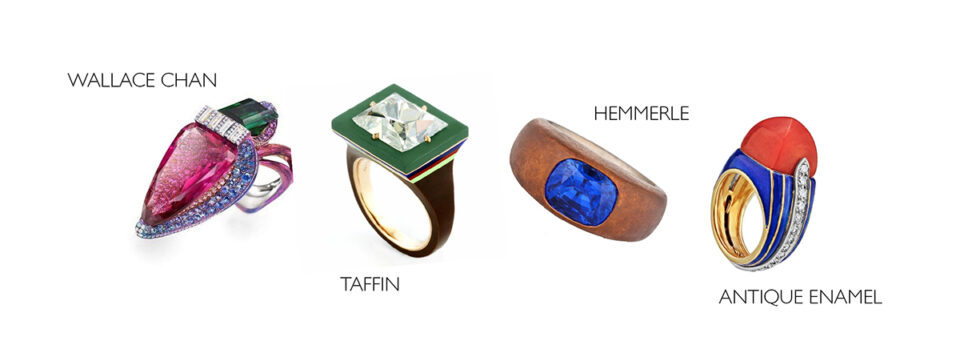
Many older metals, such as copper and bronze, have seen a resurgence in popularity in the fine jewellery sector. Again, this has been largely influenced by certain jewellery houses, such as Hemmerle, who regularly craft much sought after and collectible stone-set bronze cocktail rings and copper cocktail rings. Both copper and bronze are great options for making interesting, statement rings – if you like the colour and finish, of course. Understandably, their rusty archaic aesthetic is not for everyone.
WHAT SHOULD I CONSIDER WHEN BUYING A COCKTAIL RING?
Aside from metal type, there are a whole host of other elements to consider when purchasing a cocktail ring. For every buyer, the considerations will be unique and some of those noted below will be more important than others.
♦ When buying jewellery for yourself it is key to think of you and you only – as what works for someone else’s hand may not suit you at all, especially when it comes to statement cocktail rings.
♦ Budget is always an important factor when buying or commissioning a ring. In Tessa Packard London’s opinion, it is much better to buy one great gemstone cocktail ring than three average ones. Go for the best your money can afford, and if this is your first fine jewellery purchase then make sure you settle on a design that you truly love and ultimately suits your requirements. There is no point spending money on an emerald cocktail ring if you are looking for a neutral-toned, hard-wearing, all-day cocktail ring. Not only is the emerald cocktail ring the wrong colour, but the stone type is not ideal for long days on the finger. Better to keep looking until you find ‘the one’.
However, if your brief is to buy a real showstopper of a diamond cocktail ring – the type that goes on your finger only once in a while and usually after dark – then stone durability is going to be less of a concern. On such occasions, the most important factor will be authenticity – have I got what I paid for?
♦ As with all fine jewellery purchases, it is very important to buy only from reputable jewellers, auction houses and dealers to avoid falling upon a fake. If a prospective ring is full of bling then ask to see the respective gemstone certificates. Any great stone(s) will come with paperwork.
♦ Another fact to consider is scale. Cocktail rings, by their very nature, are usually large and pronounced, conceived to be easily noticeable on the finger. In recent history, some cocktail rings have grown to the proportions of small animals, occupying the width of three or four fingers as demand for greater design statements grow.
Whilst a three-finger knuckleduster (like our Serpent Knuckle Ring) is not for the uninitiated (and should be carefully considered), it is worth thinking about scale, regardless of whether the ring is only intended to be worn on one finger. Those with small hands and thin fingers may feel more comfortable wearing slightly more conservatively sized cocktail rings (like our Flying Saucer Ring), as overly big or heavy ones may be uncomfortable to wear and visually swamp the hand.
Those with larger fingers or bigger hands should, alternatively, reach for the chunky to balance proportions. Ultimately, there is nothing more disappointing than a gemstone cocktail ring that looks small or insignificant on the hand, regardless of finger size. If in doubt, be brave and go as big as you can muster.
♦ Clients also frequently ask us about gemstone choice: what should we go for? As touched on above, your gemstone(s) choice should be based on both colour (what you think looks pretty) as well as durability (how strong the gemstone is).
Gemstone strength is graded on the Mohs scale of hardness, with diamond at the top (scoring 10) and talc at the bottom (scoring a measly 1). In between there is range of other gemstone, including fluorite (4), quartz (7) and sapphire (9). Should you wish to buy an aquamarine cocktail ring, its hardness would be graded between a 7.5 and 8; an amethyst would score 8; a citrine cocktail ring would score 7; a jade cocktail ring would score 6; and an emerald would be scored a 7.5 to 8 on the Mohs scale.
Some gemstones that score medium to medium-high on the Mohs scale can be made more smash-proof and secure by adopting certain metal settings. For example, an emerald that is rub-over set has more chance of remaining intact if accidentally knocked than one that is claw-set (there is more protective metal surrounding the stone in a rub-over setting and fewer acute targeted pressure points than a claw-setting, thus reducing the risk that impact is made with the stone). Should you be looking to purchase an every-day emerald cocktail ring (or every-day topaz, tourmaline or amethyst ring) our recommendation would be to look for one that sees the larger, central stone rub-over set to minimise the chance of damage.
GOING VINTAGE
When it comes to cocktail rings, not everything has to be modern looking or brand, spanking new. Many Tessa Packard London clients prefer their jewellery with an antique touch. Using art deco jewellery as inspiration, we have enjoyed re-inventing designs of the past with a contemporary twist to produce elegant, fusion cocktail rings, reminiscent of a bygone era.
Aesthetically, the Art Deco period (c.1915 – 1935) is most easily characterised by its flamboyant embrace of all things geometric and patterned. These abstract motifs were applied across the visual arts, from architecture to jewellery. Art deco cocktail rings were mostly made from white metal, typically platinum, and set with a variety of gemstones, including diamond, sapphire, emerald, ruby and aquamarine. Visually, they attempted to try and convey modernity in form by using bold symmetry, crisp lines and clean cuts (qualities not found in the organic art of the Art Nouveau and Edwardian era).

Today, antique art deco cocktail rings remain popular in the jewellery market and are still coveted by collectors and clients alike. If looking to purchase one of these we would always recommend sourcing this piece of jewellery from a reputable dealer, jeweller or auction house to avoid disappointment.
When examining a potential antique purchase, take time to examine the cocktail ring carefully. Many examples of antique art deco cocktail rings are actually paste or costume or set with synthetic coloured stones (a new scientific advancement of the time), so it’s important to get advice from someone in the industry should you choose to buy jewellery from a market stall or from an unknown seller. If the cocktail ring is too good to be true in value, it probably isn’t period fine jewellery.
When buying antique cocktail ring it’s also important to make sure a piece looks sound and has the right paperwork to go with it. Check the metal settings for damage and points of weakness, particularly the metal claws (if there are any) as they can become fragile over time.
If you are satisfied with the physical condition of the antique cocktail ring, check the documentation for it. All noteworthy diamond estate jewellery will come certificated, usually with a GIA certificate, explaining the cut, clarity, colour and carat weight of the diamonds incorporated in the piece.
Finally, it is important to ask the seller whether the ring you wish to purchase can be resized to fit your finger. Some cocktail rings – regardless of whether they are antique or modern – cannot be easily or cheaply resized due to ring design or gemstone placement. This is most common with eternity-style bands where the stones are set all the way around the ring.
CAN I UPDATE MY OLD COCKTAIL RING?
Absolutely! Fashions change and everyone has individual taste. You might adore the art deco cocktail ring your great-grandmother wore in the roaring twenties, or you might find it far too old fashioned for your more contemporary style. If you feel the latter, it’s time to redesign your cocktail ring and create something you love and will want to wear.
A generation ago there was great trepidation about pulling apart and dismantling gifted or inherited jewellery. Thankfully, today, sentiments have changed and more and more Tessa Packard London clients are enjoying the perks of turning old, unused jewels into shiny, new heirlooms.
Below we have illustrated two of our favourite cocktail ring transformations involving a gold, diamond and sapphire bombe-style ring, and a platinum and diamond art deco-inspired cocktail ring. In both instances, the clients did not wear the old versions of the rings because they did not like the overall design and setting of the gemstones.
In the case of the gold, diamond and sapphire bombe-style cocktail ring, the aim was to use as many of the ‘old’ stones as possible in the new ring as the client liked the combination of colours and existing cuts. She also liked, in principle, the bombe-style shape of the ring and didn’t want the new ring to stray too far away from this aesthetic. The new ring just needed to look lighter, more modern and in keeping with her engagement ring, which was quite geometric and art deco in look.
Our first job was to re-cut and re-polish the central sapphire which had become dull and abraded. Once that was done, we set to work re-arranging the smaller stones into a pattern that would complement the design of the existing engagement ring. The completed gold cocktail ring is both statement but wearable and can be paired as easily with jeans and a shirt as a black-tie dress. It’s extremely hard-working and accommodating and a joy to look at.
The diamond ring came to us in a plain, 18ct yellow gold rub-over setting. In its original state it looked more like a signet ring than cocktail ring. Our job was to elevate the mount to match the beautiful 2 carat diamond that was set at the centre. The first decision we made was to re-set the large diamond into a platinum mount as we felt a silver metal tone would complement the all-diamond design better. We then added subtle but effective pave diamond detailing around the centre stone, both to draw the eye in and give movement to the piece. We also increased the width of the band overall to make the diamond cocktail ring look a bit chunkier than before, so that it really stood out on the finger as requested.
The end result is a truly stunning diamond cocktail ring that is neither flashy nor simplistic. It strikes the perfect balance between statement and easy-to-wear, as any every-day cocktail ring should.
For further information on updating and transforming old cocktail rings into new please visit our Tessa Packard London online Bespoke page or email us directly at [email protected].
CARING FOR A COCKTAIL RING
All jewellery needs some TLC from time to time, and no exception should be made for the statement cocktail ring.
♦ Cocktail rings that are worn frequently should be sent to a professional for an annual check-up once a year; those worn less often can normally be given a look over one every two years or as required. These check-ups are extremely important as they aim to spot and rectify any structural or setting problems with the cocktail ring before real damage is done.
Fragile claws left unchecked, for example, can result in gemstone damage or loss; a thinning metal band can snap if hit, likewise resulting in the loss of the entire ring. Regular check-ups will also allow your antique cocktail ring or contemporary cocktail ring to be professionally cleaned.
♦ With regular wear, grime, dust and dirt accumulates in all the cracks and crevices of a ring, often dulling down the sparkle of both metal and gemstone. A diamond cocktail ring can look truly transformed after a much-needed deep clean.
♦ On a day-to-day basis, it is important to try and be mindful of your cocktail ring when storing it as well as wearing it. Jewellery should always be kept in a clean, dry place away from direct sunlight exposure and other atmospheric elements. Storing cocktail rings near or next to radiators, windowsills or rooms with excess condensation (like a wet room or bathroom) is not a good idea as it can cause metal and gemstone damage.
Silver is particularly susceptible to tarnishing. Keeping silver cocktail rings in closely sealed tupperware boxes or air-tight plastic bags can help reduce the effects of unwanted atmospheric conditions.
♦ Cocktail rings should always be kept in their own pouch or box to prevent them colliding with other cocktail rings or pieces of jewellery. When two or more cocktail rings collide, one ring can easily scratch another, especially if diamond cocktail rings are placed among those containing lesser hard stones (like turquoise or pearl).
♦ Skin and hair products should generally avoid contact with all jewellery, including cocktail rings. The chemicals in perfumes, body creams, lotions, hairspray and cleansers can cause damage to precious metals and gemstones, particularly those which are vermeil or gold plated, or contain softer, vulnerable stones.
♦ It is also important to avoid cocktail rings coming in contact with any cleaning or vanish products, such as bleach, as these will cause irreparable damage to certain metals, finishes and gemstones. If in doubt, take off your rings or put on gloves!
♦ It is also advisable to remove cocktail rings when partaking in any physical or labour intensive activities, such as gardening or hiking, as these style rings do not do well when paired with strenuous exercise or action sports. We would also recommend that you remove all cocktail rings from your fingers when going to sleep, taking a bath or shower, or swimming in a pool to avoid them coming into contact with unfriendly chemicals.
Tessa Packard London regularly assists with the repair and reconditioning of all jewellery, including cocktail rings, both antique and new. For any enquiries please kindly email [email protected] and we would be delighted to offer our opinion and send you a quote for the required work.


